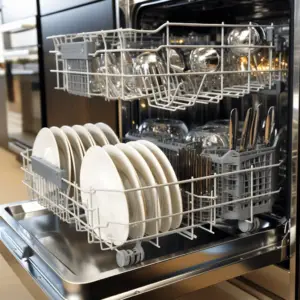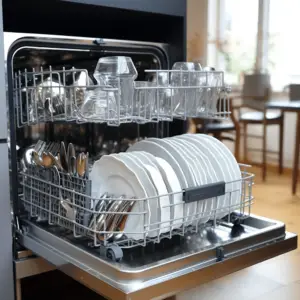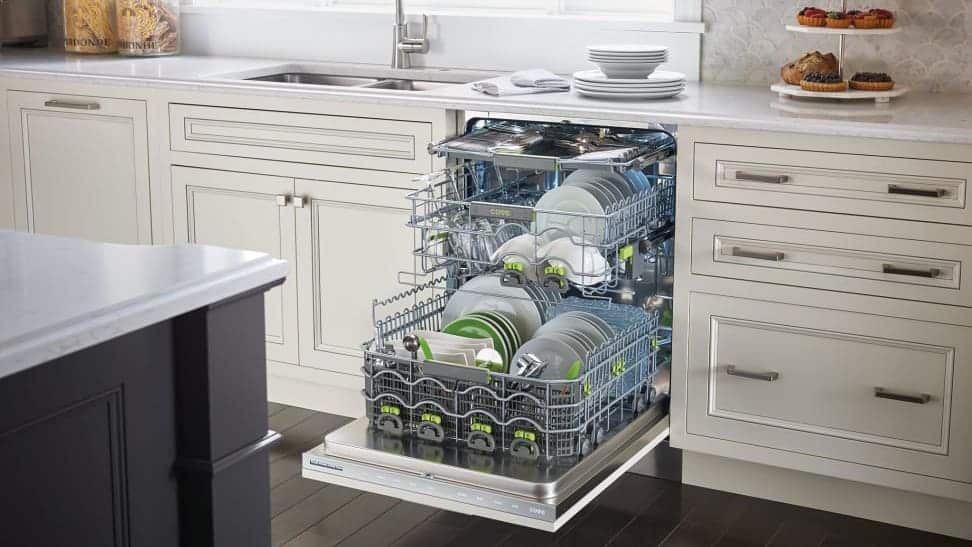Rack Dishwasher Not Cleaning Effectively, It’s generally a brilliant idea to understand how the dishwasher functions to identify potential issues. Water does not always flow into dishwashers. Water enters the dishwasher and accumulates in the little basin at the bottom. After that, a heating element heats the water, and the dishwasher’s microprocessor releases the cleaning detergent.
The pump housed in the dishwasher’s center pushes water up via the two sprayer arms. Based on the selected cycle and instructions, the dishwasher continues to pump the water through sprayer arms for a specified period. The dirty water then flows away and is replaced by fresh water.
To clean the dishes and get rid of food leftovers or detergent, clean water is then delivered up through the same sprayer arms. The step helps in ensuring that utensils are clean and ready for use.
Depending on the selected cycle, the dishwasher may additionally feature a warming or drying process whereby air within the appliance is heated to facilitate the drying of the dishes and, in some circumstances, even sterilize them.
Table of Contents
Common Reasons For Top Rack Dishwasher Not Cleaning and How To Fix

Nothing is more annoying than cleaning your dishes only to find that the top rack is not working. Luckily, the problem of the dishwasher not cleaning the top rack can be fixed even without hiring the services of a professional technician.
If your dishwasher is not cleaning at the top rack, it can be due to low water pressure, a blocked spray arm, or a damaged spray arm seal. Too many home appliances running at once, a kink in the dishwashing hose, or a blocked filter compartment are all potential causes of low water pressure.
Let’s discuss in detail what makes the top rack dishwasher not clean utensils effectively as expected and their solution(s).
Obstructed Spray Arm
Tall objects hinder the spray arm’s ability to rotate. The dishes on the top rack won’t be washed if water can’t flow through the spray arm.
Therefore, after filling the dishwasher with elongated utensils, ensure that the upper spray arm can spin freely.
If the spray arm is obstructed as it tries to make its movement, remove the elongated utensils and wash them by hand.
Broken Spray Arm Seal
The spray arm seal on a dishwasher prevents water from leaking. Therefore, if it breaks, you need to repair it.
With a broken spray arm seal, water will seep out and not reach the dishes on the top rack. Broken spray arm seals on most dishwashers are reasonably simple and cheap to fix.
Follow the steps below to replace the damaged seal on the spray arm.
- Unplug the dishwasher.
- Take the top dishrack off.
- Find the connecting arm for the spray arm.
- Remove the two screws holding the spray arm to the lid.
- To release the connecting arm, pull it off using a flathead screwdriver.
- With a moist cloth, wipe the spray arm unit.
- Reattach the new seal to the connection arm.
- Use the two screws to firmly fix the replacement seal to the lid.
- Return the top dishrack to its position.
Clogging of the Rack Propeller Jets
The best dishwashers clean dishes with high-pressure propeller jets. To clean utensils thoroughly, the jets should be directed at the dishes. A dishwasher needs a jet sprayer with several separate jets below the top rack to effectively clean the dishes on the top track.
In many areas, hard water is a serious threat to the rack propeller jet. Hard water leaves minerals to accumulate near the spray openings. Water flow is impeded when hard water deposits minerals near the spray openings. The flow is significantly reduced even if one or two spray apertures are partially blocked.
To troubleshoot the clogged rack propeller jets, you should turn off the power supply to the dishwasher before disassembling. The rack propeller jet is located under the top rack. Therefore, you should detach your dishwasher carefully until you locate it.
Check whether the openings of the propeller jets are patent. Rack Dishwasher Not Cleaning Effectively there are mineral deposits at the heads, remove them gently using a cloth. For the firmly fixed mineral deposits, you can consider having a strong object to dislocate them.
When you’re sure the propeller jet is fully functional, restart the dishwasher and check whether the dishwasher is cleaning dishes at the top rack.
Clogging Of the Upper Spray Arm
Food particles, soap residues, or hard water deposits might block the upper spray arm. Follow these steps to repair the clogged upper spray arm:
- Remove the Upper spray Arm: A ratchet and socket may be required to take out the upper arm. Depending on the type of your dishwasher, you could require a different size socket. Once the dishwasher’s arm has been removed, use a socket and ratchet to remove clamps and arms.
- Clean spray arm holes: You’ll need a wire or brush to clean the spray arm holes. If it’s made from steel, get steel wire; if it has a plastic material, get a cheap metal hanger. To remove any food, minerals, or detergents stuck within the jet holes, twist the hanger or wire so that it will fit inside and dislodge the debris..
- Wash the upper spray arm: After removing food and dirt from the spray arm, immerse it in white vinegar for proper cleaning and dislodgement of stubborn food left over. You can use either a baking dish or fill the sink with water containing vinegar. Return the upper spray arm to the dishwasher after soaking it for 10 to 15 minutes.
Low Water Pressure

Rack Dishwasher Not Cleaning Effectively the top rack of your dishwasher doesn’t clean dishes adequately, you could have a low water pressure issue within the dishwasher or your entire household.
The water in the dishwasher is typically split equally between the lower and upper racks. If the water pressure is low, both racks won’t have enough water pressure. The bottom rack of the dishwasher will most likely become clean, while the top rack will remain unclean.
There are a variety of causes for low water pressure. First, you might be running the dishwasher while engaging in other water-intensive tasks. For example, the dishwasher is operating while someone is taking a shower.
In addition, there might be a kink in the water lines reducing the amount of water flowing through the hose. Another element that reduces water pressure within the dishwasher is the blockage of the filter compartment.
When the filter is blocked, water is prevented from entering the circulation pump; therefore, the necessary pressure is not attained.
To correct the problem of low water pressure and ensure that the top rack dishwasher is cleaning, avoid engaging in other water-intensive tasks while the dishwasher is working. Secondly, correct the kink and obstruction within the water line. The clogged filter compartment needs to be removed and subjected to thorough cleaning.


